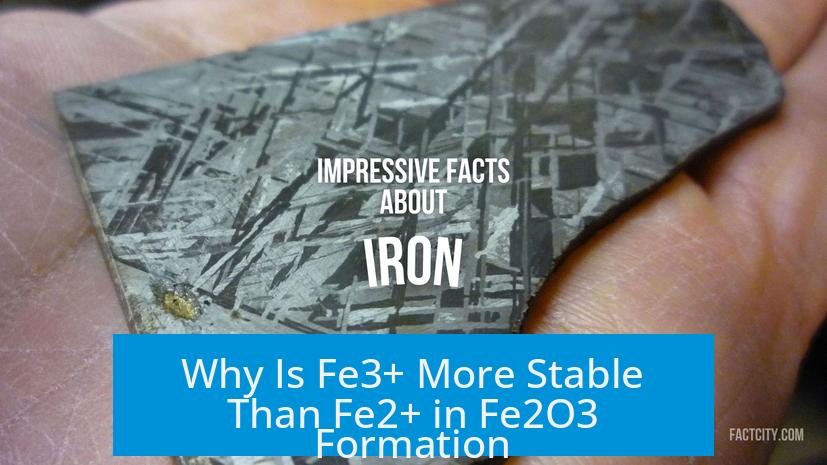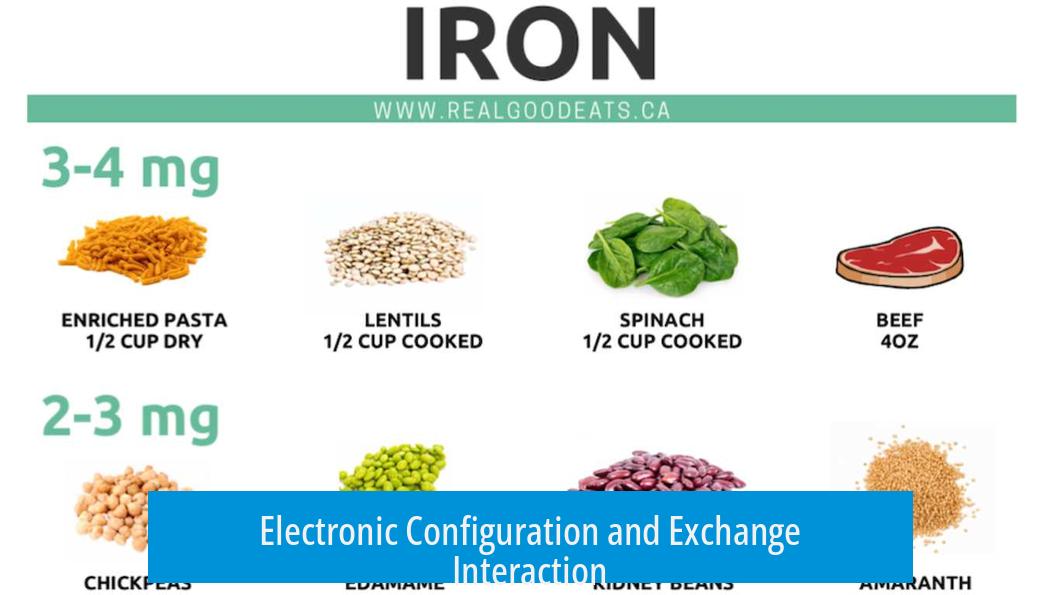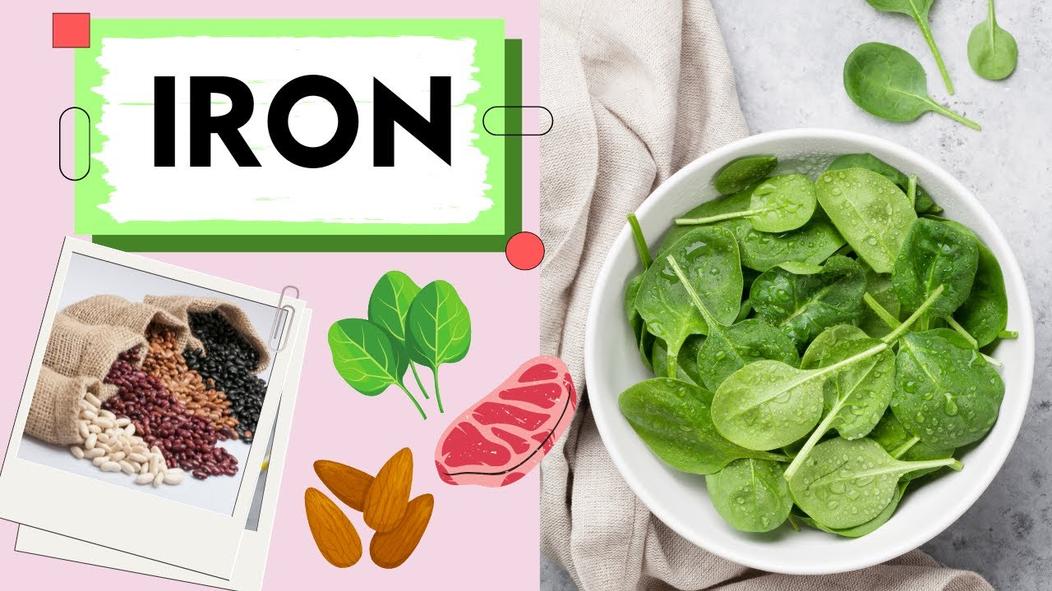Why Is Fe3+ More Stable Than Fe2+ in Fe2O3 Formation?

Fe3+ proves more stable than Fe2+ during the reaction of iron with oxygen to form Fe2O3 because the 3+ oxidation state benefits from electronic exchange interactions and favorable crystal field effects, while Fe2+ suffers from electron repulsion and distortions.
Electronic Configuration and Exchange Interaction

Iron starts as a neutral atom with 8 d-electrons. In Fe3+, it loses three electrons, leaving 5 electrons occupying separate 3d orbitals. These electrons all have parallel spins, creating strong exchange interactions. These interactions lower the overall energy, stabilizing Fe3+.
In contrast, Fe2+ holds an extra electron in one 3d orbital, paired with another electron of opposite spin.

- This paired electron generates electron-electron repulsion.
- It prevents exchange interaction with other electrons.
- The increased repulsion raises the energy, reducing stability.
Crystal Field and Ligand Field Theories
In nature, iron commonly adopts octahedral geometry with ligands surrounding the metal center. The octahedral crystal field splits the five d orbitals into two energy levels: the higher energy eg orbitals (dz2 and dx2−y2) and the lower energy t2g orbitals (dxy, dxz, dyz).

In Fe3+, the five electrons occupy all t2g orbitals singly with parallel spins, leading to a symmetric, stable arrangement.
Adding an extra electron for Fe2+ results in an electron pair in one orbital, triggering Jahn-Teller distortions. The complex distorts to reduce energy, but this distortion means less overall stability compared to Fe3+.

Role of Environmental Oxygen
Fe2+ remains fairly stable under low oxygen conditions. Before Earth’s atmosphere had abundant oxygen, Fe2+ was more common. However, molecular oxygen (O2) strongly oxidizes Fe2+ to Fe3+.

The reaction:
4 Fe + 3 O2 → 2 Fe2O3
reflects oxygen’s role as an oxidizer, removing one electron from Fe2+ to form Fe3+ in Fe2O3.
This transformation favors the more stable Fe3+ chemical state.
Summary of Stability Factors
| Aspect | Fe2+ | Fe3+ |
|---|---|---|
| Number of d electrons | 6 | 5 |
| Electron arrangement | One paired electron, increased repulsion | All unpaired, maximum exchange interaction |
| Crystal field distortion | Jahn-Teller distortion likely | Stable octahedral geometry |
| Environmental influence | Stable in low O2 | Favored in presence of O2 (oxidation) |
Key Takeaways
- Fe3+ has five unpaired d-electrons, leading to exchange interaction stabilization.
- Fe2+ has a paired electron causing repulsion and Jahn-Teller distortions, reducing stability.
- Oxygen strongly oxidizes Fe2+ to Fe3+, driving Fe2O3 formation.
- Octahedral crystal field splitting favors Fe3+ stability in iron oxides.
Why is Iron(III) More Stable Than Iron(II) in Fe2O3? The Oxidation State Mystery
When it comes to transition metals like iron, the oxidation state +3 (Fe3+) is more stable than +2 (Fe2+) in compounds such as Fe2O3. Why is that? Let’s break down this chemical puzzle with electron-sharing, orbital dance, and a splash of nature’s fingerprints.
Imagine iron as a social electron party: the number of guests (electrons) and how they mingle makes all the difference.
Electronic Configuration: The Half-Filled Fan Club
Iron’s directional d-orbitals are like seats at a dinner table. Elemental iron starts with 8 d-electrons. Lose three (Fe3+), and you have 5 d-electrons half-filling the five 3d orbitals. Lose only two (Fe2+), and there are 6 d-electrons — meaning one orbital has two guests seated opposite each other.
Why is half-filling better? This is where exchange interaction shines. Having unpaired electrons spread with the same spin across orbitals stabilizes the configuration. In Fe3+, with 5 unpaired electrons all aligned spin-wise, the energy is low and the arrangement stable.
But in Fe2+, that extra electron pairs up in one of those orbitals with opposite spin—this creates repulsion and raises energy (no one likes a cramped chair at the dinner table). So iron “prefers” to lose that extra electron to relax into the Fe3+ state.
The Role of Crystal Field and Ligand Field Theory
Beyond just electrons counting themselves, the environment matters. Iron ions mostly hang out in an octahedral neighborhood surrounded by molecules or ions like O2 or water.
Crystal field theory explains how iron’s five d orbitals split energy-wise in this octahedral crowd. The dz2 and dx2 – y2 orbitals sit a bit higher in energy compared to dxy, dxz, and dyz orbitals. In Fe3+, the five electrons nicely occupy the lower-energy orbitals singly, all with the same spin, making the complex stable.
When you add the sixth electron (Fe2+), it finds itself forced to pair up in one of these orbitals. This causes not only electron repulsion but also structural changes known as Jahn–Teller distortions. The molecule contorts to minimize instability, but this added stress makes the Fe2+ form less stable than Fe3+.
Natural Environment’s Influence: Oxygen’s Oxidizing Power
Would Fe2+ be king of the hill without oxygen? Actually, yes—early Earth’s atmosphere had very little O2. Iron(II) was plentiful back then. But the rise of oxygen flipped the game.
Oxygen molecules (O2) are strong oxidizers — they greedily snatch that extra electron from Fe2+, turning it into Fe3+. This explains why in oxygen-rich environments, Fe3+ compounds like Fe2O3 (rust) dominate.
Iron banding patterns in rocks provide geologists a time machine to read oxygen-level changes in Earth’s history, showcasing how Fe’s oxidation states respond to environmental shifts.
Summary Table: Electron Count and Stability
| Iron State | Electrons Lost | d-electrons Remaining | Electron Pairing | Stability |
|---|---|---|---|---|
| Fe (elemental) | 0 | 8 | 4 pairs | Neutral (metal) |
| Fe2+ (Iron(II)) | 2 | 6 | 1 extra pair (paired electron) | Less stable due to repulsion & distortions |
| Fe3+ (Iron(III)) | 3 | 5 | All unpaired (half-filled) | Most stable due to exchange interaction |
Why Does This Matter?
Understanding these oxidation state stabilities helps chemists explain rust formation, biological iron cycles, and design iron-based catalysts. It also demonstrates how atomic structure governs what compounds form and persist.
Ever wonder why your bike rusts with that unmistakable red color (Fe2O3)? It’s all about Fe3+ winning the stability contest in the presence of oxygen. Oxygen is like nature’s electron thief, pushing iron to lose that second electron, settling into the cozy Fe3+ state.
Tips for Chemistry Explorers
- Look for half-filled subshells—these electrons love to keep their spin the same.
- Remember that paired electrons cause repulsion; metals dislike overcrowding their orbitals.
- Consider the environment—oxidizers like O2 turn Fe2+ into Fe3+ naturally.
- Use crystal field theory as a lens to visualize orbital splitting and electron distribution.
To put it simply, the Fe3+ state is like the well-organized host of the electron party—each guest comfortably seated alone, no fights, no distortions. Fe2+ tries to squeeze an extra guest in a crowded room, triggering discomfort and instability. Nature, thankfully, prefers the peaceful party.
Final Thoughts
So next time you see rust or read about iron chemistry, remember the humble electron’s role. It’s not just losing or gaining charges; it’s about reaching a stable balance driven by fundamental physics. Fe3+ is nature’s favored guest in iron oxides like Fe2O3, thanks to half-filled orbital harmony, crystal field stabilization, and oxygen’s oxidizing touch.
Who knew electrons could be such picky party planners?
Why is Fe³⁺ more stable than Fe²⁺ in Fe₂O₃ formation?
Fe³⁺ has five unpaired 3d electrons, which create exchange interactions that lower its energy. Fe²⁺ has an extra paired electron causing repulsion and instability. Oxygen removes this extra electron, favoring Fe³⁺ in Fe₂O₃.
How does electron configuration affect iron’s oxidation states?
Fe³⁺ has half-filled 3d orbitals with all electrons unpaired, leading to stability. Fe²⁺ has one paired electron in a 3d orbital. This pairing increases electron repulsion and reduces stability, making Fe³⁺ more favorable.
What role does crystal field theory play in Fe³⁺ stability?
In an octahedral field, certain d orbitals split and fill with electrons differently. Fe³⁺’s five electrons fill orbitals with the same spin, avoiding repulsion. Fe²⁺’s extra electron pairs up, causing distortions and less stability.
Why does oxygen favor the formation of Fe³⁺ over Fe²⁺?
Oxygen is a strong oxidizer and removes the extra electron from Fe²⁺. This converts iron into Fe³⁺, which then forms the stable Fe₂O₃. This oxidation process drives the preference for Fe³⁺ in iron oxides.
Is Fe²⁺ stable under any conditions?
Yes. Fe²⁺ is stable in environments with little oxygen, such as early Earth. Without oxygen, Fe²⁺ does not oxidize readily. However, in oxygen-rich conditions, it is pushed toward Fe³⁺ formation.





Leave a Comment